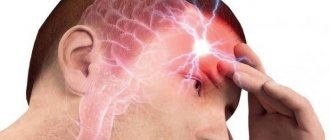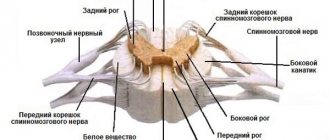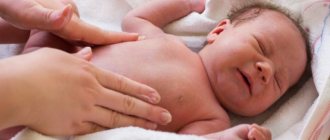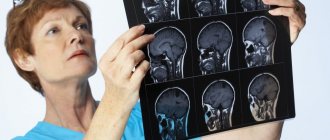Treatment of the disease
Treatment of torsion dystonia is conservative and surgical.
- Surgery:
- Stereotactic operations are indicated in cases where the disease rapidly progresses and deprives the patient of the ability to work and the ability to self-care. Stereotactic operations are aimed at destroying brain structures and are responsible for pathological impulses. Preparation for such an operation takes place in several stages. First, a special stereotactic frame is attached to the patient's head. A magnetic resonance or computed tomography scan of the brain is performed. Then, using special calculations using a tomogram and stereotaxic landmarks, the coordinates of the target structure are calculated. The surgeon accesses the required part of the brain and destroys the required structures in various ways. The duration of the disease and its severe course in the later stages are not contraindications to surgical intervention. After stereotactic operations, hyperkinesis and muscle rigidity in most cases decrease or disappear;
- it is possible to perform surgical interventions on peripheral nerves (neurotomy, radiotomy) for local forms of torsion dystonia. At the same time, their pathological effect on muscle groups is eliminated;
- in the later stages of torsion dystonia with joint deformities and muscle contractures, orthopedic operations are sometimes performed, so patients may also need the help of an orthopedic surgeon to correct pathological processes in the joints.
- Electrical stimulation of subcortical structures is the latest technique, which consists in the fact that electrodes producing electrical discharges are implanted into the area responsible for pathological impulses. These impulses suppress the activity of the pathological area of the brain. The operation is also performed using stereotactic guidance. After determining the coordinates of the target structure, the surgeon performs surgical access under intraoperative X-ray control and installs electrodes in certain subcortical nuclei. The neurostimulator itself, which produces electrical impulses, is a small device that is implanted into the subcutaneous fatty tissue of the subclavian region. After surgery, high-frequency electrical impulses are constantly sent to the patient's brain. In addition, the patient can adjust the parameters of the neurostimulator depending on his state of health.
- Drug therapy consists of prescribing certain groups of medications:
- anticholinergics;
- benzodiazepines;
- neuroleptics;
- anticonvulsants;
- muscle relaxants;
- Botox injections;
- GABAergic drugs;
- tranquilizers;
- glucocorticoids;
- adrenergic blockers;
- B vitamins.
Local forms of torsion dystonia (spasm of the hand, torticollis, adducted feet) are treated with botulinum toxin. It blocks the transmission of nerve impulses in those muscles in which spasm occurs.
Therapeutic gymnastics - anaerobic physical activity has a positive effect on the course of torsion dystonia. Hydrotherapy is also indicated.
Pathogenesis and clinical manifestations
Direct torsion dystonia develops as a result of a disturbance in the metabolism of the neurotransmitter dopamine in the extrapyramidal system of the brain (subcortical motor center). In this case, two forms arise - dopamine-dependent (rigid) and dopamine-independent (hyperkinetic). This is a very important point, since the treatment will vary for different forms. It is also known that the autosomal dominant variant is milder than the autosomal recessive variant.
An important sign of torsion dystonia is its gradual development. Initially, the patient complains of small rotational spasms in various parts of the body, most often on the extremities (especially the lower ones). This usually occurs on one side of the body. In this case, difficulties with walking very often arise.
Subsequently, such corkscrew-like spasms begin to appear much more often in other parts of the body. This is the so-called local form. It can become generalized, in which large muscle groups are involved. Symptoms intensify if the patient tries to concentrate and make the right movement. During sleep, symptoms of the disease usually disappear.
If the hyperkinetic form is characterized by clonic convulsions (i.e., muscle contraction is followed by its relaxation), then with the rigid form spastic ones develop (convulsions in which the muscles are tense for a long time). In this case, fixed pathological postures arise, both in local areas and in the entire body.
With the further development of torsion dystonia, complications such as writer's cramp, contractures, joint deformation, curvature of the spine and torticollis appear. The gait changes, and disturbances in speech, chewing, swallowing, and breathing may occur. Due to the constant load on the muscles, their hypertrophy occurs.
Diagnosis of the disease
The diagnosis is made based on clinical data. Usually it is not in doubt if there are already cases in the family.
Methods of analysis and diagnostic tests indicated for this pathology:
- X-ray examination.
- Electromyography - allows you to identify disturbances in the activity of electrical potentials of muscles.
- Magnetic resonance imaging of the brain and spinal cord - to assess areas of damage.
- Electroneuromyography - allows you to evaluate the electrical activity of skeletal muscles and peripheral nerves.
- Electroencephalogram - helps to identify disturbances in the bioelectrical activity of the brain.
Differential diagnosis is carried out with torsion-dystonic syndromes, especially those caused by the chronic form of epidemic encephalitis and hepatocerebral dystrophy. Differential diagnostic significance for epidemic encephalitis is the acute development of the disease, sleep disturbance, diplopia, convergence insufficiency, gaze convulsions, autonomic disorders and, in later stages, symptoms of parkinsonism. Hepatocerebral dystrophy, in contrast to torsion dystonia, is characterized by a low level of ceruloplasmin in the blood, the presence of a Kayser-Fleischer ring (deposition of a greenish-brown pigment containing copper on the periphery of the cornea of the eyes), and cirrhosis of the liver.
Other diseases of the extrapyramidal system that occur with torsion-dystonic syndromes differ from torsion dystonia in that they do not progress and undergo reverse development (to varying degrees) with a decrease in the frequency and severity of hyperkinesis. In their clinical picture, along with hyperkinesis, there are other symptoms of brain damage that are not observed with torsion dystonia.
conclusions
Torsion dystonia is a fairly rare disease of hereditary etiology. In some cases, an acquired form develops. With this pathology, the structure of the extrapyramidal system of the brain is disrupted, which leads to the occurrence of tonic and spastic convulsions and the formation of pathological postures. As the disease progresses, it provokes the development of serious complications and significantly worsens the quality of life of patients. However, with proper and timely treatment, the prognosis is quite favorable.
Prices
| Disease | Approximate price, $ |
| Prices for diagnosing migraine | 7 060 — 8 260 |
| Prices for diagnosing childhood epilepsy | 3 100 — 4 900 |
| Prices for brain shunting for hydrocephalus | 33 180 |
| Prices for treatment of Parkinson's disease | 58 600 |
| Prices for migraine treatment | 9 680 |
| Prices for the diagnosis of amyotrophic lateral sclerosis | 6 550 |
| Prices for diagnosing epilepsy | 3 520 |
| Prices for rehabilitation after a stroke | 78 300 — 82 170 |
| Prices for treatment of childhood epilepsy | 3 750 — 5 450 |
| Prices for treatment of multiple sclerosis | 4 990 — 17 300 |
General information about pathology
Torsion dystonia (from the Latin “torsio” - twisting) is a chronic disease of the central nervous system, entailing tonic muscle disorders with the subsequent appearance of hyperkinesis and the formation of aphysiological postures in the patient. A pathology of this nature was first described in 1907, but given the symptoms it was classified as hysterical neurosis.
Later, in 2011, G. Oppenheim proved the organic nature of torsion dystonia, but for a long time there were numerous discussions on the nosological affiliation of the disease. The pathogenesis of torsion dystonia still remains unexplored.
The diagnosis of torsion dystonia is made to patients of any age. However, the vast majority of patients are young people under twenty years of age. 65% of the disease is diagnosed in children and adolescents under 15 years of age. Depending on the place of residence, the incidence of the pathology is 1 case per 160 thousand people or 1 per 15,000. On average, 40 cases per 100,000 population occur.
Torsion dystonia is considered a fairly pressing problem in modern medicine. This is due to the fact that the disease is becoming more common and leads to disability in young people. Moreover, today there is no truly effective pathogenetic therapy to minimize the complications of the disease.
Classification of torsion dystonia
The focal form of torsion dystonia is accompanied by tonic spasms of individual muscles. This group includes:
- Writer's cramp. In this case, the hand muscles contract involuntarily, which is why the patient has problems with writing. This also includes spasms of the foot and neck muscles.
- Oromandibular dystonia – there is an involuntary contraction of the masticatory muscles (mouth, cheeks, tongue).
- Idiopathic blepharospasm - due to the fact that a tonic spasm of the orbicularis oculi muscle occurs, the patient experiences involuntary closure of the eyelids.
- Spasmodic dysphagia - the patient complains of difficulty swallowing function or its complete absence.
- Spasmodic dysphonia - there is a tonic contraction of the vocal muscles, which is accompanied by loss of voice production function.
Other forms of torsion dystonia are:
- Hemidystonia – the muscles of half the body are affected and impaired.
- Generalized form - almost all muscle groups are subject to uncontrolled contraction.
- Segmental form of dystonia - tonic contraction is observed in several muscle groups, which are mainly located nearby.
- Multifocal – a combination of several focal forms of torsion dystonia.
Forecasts
The outcome of idiopathic torsion dystonia depends on the time of manifestation of the disease. The early onset of pathology entails a severe course. In this case, early generalization and deep disability of the patient develops. When intercurrent infections occur, the patient's death follows.
With timely surgical treatment, the prognosis is more favorable. In most cases, after surgery, rigidity and hyperkinesis disappear in patients. They retain the ability to walk, perform complex movements and care for themselves. In cases with secondary torsion dystonia, a favorable prognosis will be only if timely and effective treatment is possible. In this case, regression of spasms and hyperkinesis is noted.
Clinical picture
The first symptoms of torsion dystonia are focal spasms. They appear periodically and mainly when there is a load on the muscle group that is susceptible to the disease. For example, at an early stage of development, the writing form of pathology appears only during writing. Involuntary contractions correspond to hyperkinesis (motor acts that the patient cannot control). Such movements may have the following character:
- tonic;
- myoclonic;
- tick-shaped;
- hemiballic;
- tremor-like;
- choreatic;
- athetoid;
- myoclonic.
At the same time, hyperkinesis is less pronounced in the distal parts of the limbs than in the proximal ones. Rotational movements of the torso or limbs along the longitudinal axis are typical for pathology.
A characteristic symptom is a change in the number of involuntary acts or spastic postures. They correspond to the functional activity and body position of the patient, as well as his emotional state. Thus, while walking, the patient experiences corkscrew-like movements of the body, and when trying to perform a certain action, involuntary contraction of the muscles of the limbs.
All manifestations of torsion dystonia disappear during a period of calm, namely during sleep. Moreover, patients can adapt to their movement disorders and temporarily reduce the severity of involuntary movements. At this time, they can perform complex motor movements and fully maintain self-care.
Frequent and involuntary muscle contractions often lead to hypertrophy or prolonged spasm. In the latter case, connective tissue replacement of muscle tissue occurs, as a result of which shortening of the muscle is formed and its ability to stretch is lost. Constant and prolonged muscle spasms lead to degenerative processes that develop in the joints. Next, joint contracture is formed.
Tonic spasms of the back muscles provoke the development of the following diseases:
- scoliosis;
- rachiocampsis;
- lumbar lordosis;
- kyphoscoliosis.
At later stages of the disease, the patient's respiratory function may be impaired.
In some cases, at an early stage of development of the pathology, its local forms are noted, which over time and without proper treatment develop into a generalized form. The generalized form is accompanied by an “unusual” gait with a wide gait. Periodically, the patient's posture becomes abnormal and the person freezes in it. In some patients, isolated local manifestations persist during the disease, and the dystonic process passes without generalization. As a rule, this clinical picture is observed in patients aged 20-40 years.
Reasons for the development of torsion dystonia
The causes and mechanism of development of torsion dystonia still remain in question. In medical practice, symptomatic and idiopathic cases of pathology are known. The only thing that can be said with certainty is the hereditary nature of torsion dystonia. There is also evidence that there are several ways of inheriting the disease: autosomal dominant and autosomal recessive. In the case of autosomal dominant inheritance of the pathology, it manifests itself at a later age and is characterized by a relatively mild course.
Symptomatic torsion dystonia is diagnosed when:
- Wilson's disease;
- cerebral palsy;
- epidemic encephalitis;
- Huntington's chorea;
- brain tumors;
- traumatic brain injuries.
There is a widespread belief among doctors that the pathology in question is a consequence of a disorder in the metabolism of dopamine in the body. This assertion is not groundless. Thus, in most cases of a confirmed diagnosis of torsion dystonia, an increased level of dopamine hydroxylase is found in the blood of patients.
Regarding the pathogenetic theory of the disease, the most common one is the one that says that the disease develops as a result of a disorder of subcortical regulation. This theory is confirmed by pronounced morphological degenerative changes in the subcortical nuclei (substantia nigra, basal ganglia, red, subthalamic).









